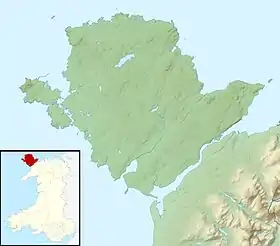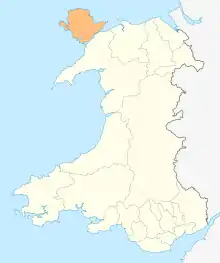Porth Wen Brickworks
Porth Wen Brickworks is a now disused Victorian brickworks which produced fire bricks, made from quartzite (silica) used to line steel-making furnaces. The substantial remains include a number of buildings and the remains of some of the machinery, but has some damage from sea erosion. The site is a scheduled monument.
| Porth Wen Brickworks | |
|---|---|
.jpg.webp) Kilns and chimneys at the brickworks | |
| Type | Brickworks |
| Location | Anglesey, Wales |
| Coordinates | 53.424°N 4.406°W |
| OS grid reference | SH 4019 9465 |
| Official name | Porth Wen Brickworks |
| Designated | 27 October 1986 |
| Reference no. | AN109 |
 Location in Anglesey | |
Location
The brickworks is in a spectacular location on the western side of Porth Wen (English: White Bay) in the community of Llanbadrig in the north of Anglesey, and is about 2 km (1.2 miles) west of Porth Llechog and 3 km (1.9 miles) north-east of Cemaes.[1][2] The brickworks was established because of the readily available quartzite from the nearby quarries, a major component of fire bricks.[3]
As with much of coastline of Anglesey, the brickworks lies within the area of the Anglesey Area of Outstanding Natural Beauty.[4]
Description
Porthwen Brickworks includes quarries, an incline tramroad to the works, and includes a crushing house, moulding shed, drying sheds, and kilns. The brickmaking operation was supported by storage hoppers, engine house, boiler house, chimneys, warehouse and a quay.[5]
Brickmaking started on the site in the mid 19th century, with the tramroad being added later, and the existing buildings being built in the early 20th century.[6] Although the brickworks ceased production in the first half of the 20th century (sources vary on the date; either 1924 or 1949),[1][6] the buildings and much of the equipment remain in situ, and the site shows:
...the visual scars of time and nature on its rural-industrial face as well as just the immense history built into the very bricks and stones
— Ian Banks[7]
Quarries and incline
.jpg.webp)
The brickworks were supplied from two quarries to the north-west of the works.[8][9] A tramroad from one of the quarries leading to a winding house and incline was shown on the 1st edition OS map, 1889.[10]
The winding house includes two lateral walls of mortared walls of rubble masonry supporting a square drive shaft and bearings. The remains of the walls are splayed at the bases and roughly 4.5 m (10 feet) in length, 0.95 m (3 feet) wide up to a height of 3 m (10 feet).[10][11] The drive shaft supported three wheels each with eight spokes. One wheel is roughly 2 m (7 feet) in diameter and the other two are 1.5 m (5 feet) in diameter. The larger wheel was a banding-break and the other two were driving wheels for lowering and raising trucks on the incline. A wooden beam with a control mechanism remains in front the drive shaft. A second similar wooden beam lies nearby but is no longer in position.[10][11][12]
Near the winding house are the remains of a storage shed roughly 4 m (10 feet) by 5 m (20 feet) with walls that supported a gabled roof of profiled sheeting and is probably more recent than the winding house, built in a period of improvement in the early 20th century.[13]
The incline consisted of two tracks which have been removed but the track bed remains with retaining walls of random rubble masonry roughly 1 m (3 feet) deep. The incline was gravity powered.[12][14]
Brickmaking

The incline terminated at a crushing house where pieces of quartzite were broken up with a knapping machine. The pieces were passed down chutes to lower levels for further processing, resulting in a fine powder at the lowest stage. It is likely that the pieces of quartzite were reduced by hammer with the workers wearing iron covered gloves.[1][15][16]
The resulting powder was mixed with lime and water in a pan mill. The resulting paste was then moulded and pressed into bricks in the moulding shed, and then dried out in drying sheds.[1][17][18][19] Originally bricks were made using moulding and wire cutting, but were later made using a press.[16]
After drying, the bricks were then fired in one of the three circular down-draught kilns (also known as beehive or Newcastle kilns), made of brick with iron bands and domed roofs.[20][21][22][1][7]
The brickworks also includes the remains of a boiler house, which contained a Five-drum Stirling boiler, and a small engine house for a steam engine.[23][24]
History
Porth Wen brickworks was designated as a scheduled monument by Cadw in 1986 and classified as a post-medieval industrial brickworks.[28]
References
- "Silica Brick Works, Porth Wen". Historic Environment Record (HER). Gwynedd Archaeological Trust (GAT). GAT PRN 3562. Retrieved 18 June 2016 – via archwilio (online database of the four Welsh Archaeological Trusts).
- "Section 3: Cemaes to Amlwch Port" (PDF) (Map). www.anglesey.gov.uk. Isle of Anglesey Coastal Path Project. 2005. Retrieved 18 June 2016.
- Jones, S. (1997). Coastal Erosion Survey Anglesey (PDF) (Report). Gwynedd Archaeological Trust (GAT). p. 14. GAT Report No. 251. Retrieved 17 June 2016.
- Grant, Maria; Parker, Sally (April 2014). State of the AONB Report for Anglesey (PDF). Isle of Anglesey County Council (Report). Land Use Consultants. p. 11. Retrieved 14 May 2016.
- Gwyn, David (2006). Gwynedd: Inheriting a Revolution; the Archaeology of Industrialisation in North-West Wales. Phillimore & Company Limited. pp. 116–117. ISBN 978-1-86077-432-4.
- Hill, J. (1 March 2004). "Porthwen Brickworks; Porth Wen Silica Brickworks". National Monuments Record of Wales (NMRW). Royal Commission on the Ancient and Historical Monuments of Wales (RCAHMW). NPRN 40736. Retrieved 17 June 2016 – via coflein (online database of the NMRW).CS1 maint: ref=harv (link)
- Banks, Ian (20 December 2004). "Porth Wen Brickworks, Anglesey". Urban Realm. Retrieved 20 June 2016.
- "Porthwen Brickworks: Silica Quarry". National Monuments Record of Wales (NMRW). Royal Commission on the Ancient and Historical Monuments of Wales (RCAHMW). NPRN 40737. Retrieved 17 June 2016 – via coflein (online database of the NMRW).
- "Porthwen Brickworks: Silica Quarry; Dinorben Quarry". National Monuments Record of Wales (NMRW). Royal Commission on the Ancient and Historical Monuments of Wales (RCAHMW). NPRN 528. Retrieved 17 June 2016 – via coflein (online database of the NMRW).
- "Winding House at Porth Wen, Bryn Llewelyn". heritagerecords.nationaltrust.org.uk. National Trust. MNA133966. Retrieved 18 June 2016.
- "Porthwen Brickworks: Winding Engine House". National Monuments Record of Wales (NMRW). Royal Commission on the Ancient and Historical Monuments of Wales (RCAHMW). NPRN 40740. Retrieved 17 June 2016 – via coflein (online database of the NMRW).
- "Porthwen Brickworks: Railway Incline". National Monuments Record of Wales (NMRW). Royal Commission on the Ancient and Historical Monuments of Wales (RCAHMW). NPRN 40738. Retrieved 17 June 2016 – via coflein (online database of the NMRW).
- "Storage shed at Porth Wen, Bryn Llewelyn". heritagerecords.nationaltrust.org.uk. National Trust. MNA133968. Retrieved 18 June 2016.
- "Incline at Porth Wen, Bryn Llewelyn". heritagerecords.nationaltrust.org.uk. National Trust. MNA133967. Retrieved 18 June 2016.
- "Porthwen Brickworks: Crusher House". National Monuments Record of Wales (NMRW). Royal Commission on the Ancient and Historical Monuments of Wales (RCAHMW). NPRN 40739. Retrieved 17 June 2016 – via coflein (online database of the NMRW).
- Jones, Wil. "Porth Wen Brickworks". www.anglesey-hidden-gem.com. Retrieved 20 June 2016.
- "Porthwen Brickworks: Moulding Shed and Chimney". National Monuments Record of Wales (NMRW). Royal Commission on the Ancient and Historical Monuments of Wales (RCAHMW). NPRN 40747. Retrieved 17 June 2016 – via coflein (online database of the NMRW).
- "Porthwen Brickworks: Drying Sheds". National Monuments Record of Wales (NMRW). Royal Commission on the Ancient and Historical Monuments of Wales (RCAHMW). NPRN 40745. Retrieved 17 June 2016 – via coflein (online database of the NMRW).
- "Porthwen Brickworks: Chimney". National Monuments Record of Wales (NMRW). Royal Commission on the Ancient and Historical Monuments of Wales (RCAHMW). NPRN 40748. Retrieved 17 June 2016 – via coflein (online database of the NMRW).
- "Porthwen Brickworks: Kiln (1)". National Monuments Record of Wales (NMRW). Royal Commission on the Ancient and Historical Monuments of Wales (RCAHMW). NPRN 40742. Retrieved 17 June 2016 – via coflein (online database of the NMRW).
- "Porthwen Brickworks: Kiln (2)". National Monuments Record of Wales (NMRW). Royal Commission on the Ancient and Historical Monuments of Wales (RCAHMW). NPRN 40743. Retrieved 17 June 2016 – via coflein (online database of the NMRW).
- "Porthwen Brickworks: Kiln (3)". National Monuments Record of Wales (NMRW). Royal Commission on the Ancient and Historical Monuments of Wales (RCAHMW). NPRN 40744. Retrieved 17 June 2016 – via coflein (online database of the NMRW).
- "Porthwen Brickworks: Stirling Boiler House". National Monuments Record of Wales (NMRW). Royal Commission on the Ancient and Historical Monuments of Wales (RCAHMW). NPRN 40749. Retrieved 17 June 2016 – via coflein (online database of the NMRW).
- "Porthwen Brickworks: Engine House". National Monuments Record of Wales (NMRW). Royal Commission on the Ancient and Historical Monuments of Wales (RCAHMW). NPRN 40741. Retrieved 17 June 2016 – via coflein (online database of the NMRW).
- "Porthwen Brickworks: Building". National Monuments Record of Wales (NMRW). Royal Commission on the Ancient and Historical Monuments of Wales (RCAHMW). NPRN 40746. Retrieved 17 June 2016 – via coflein (online database of the NMRW).
- "Porthwen Brickworks: Crane". National Monuments Record of Wales (NMRW). Royal Commission on the Ancient and Historical Monuments of Wales (RCAHMW). NPRN 40751. Retrieved 17 June 2016 – via coflein (online database of the NMRW).
- "Porthwen Brickworks: Loading Quay". National Monuments Record of Wales (NMRW). Royal Commission on the Ancient and Historical Monuments of Wales (RCAHMW). NPRN 40750. Retrieved 17 June 2016 – via coflein (online database of the NMRW).
- Porth Wen Brickworks. National Monuments Record of Wales (NMRW) (Report). Cadw. 27 October 1986 [Scheduled 1986]. Cadw Id: AN109.
Further reading
- Jones, William (May 2015). Anglesey Hidden Gem (kindle)
|format=requires|url=(help). ASIN B00XJQ6C2M. - Summers, Neil. "Porth Wen – An abandoned brickworks on Anglesey". www.penmorfa.com. Retrieved 20 June 2016.
External links
- "Map 1 – Cemaes" (PDF) (Map). visitanglesey.co.uk. 1:25,000. Isle of Anglesey County Council. – map of part of Anglesey Area of Outstanding Natural Beauty
- "Map B Ynys Môn – Isle of Anglesey" (PDF). Wales Coast Path. National Resources Wales. – includes Maps 13 to 28 covering the coast of Anglesey
- Jenkins, Phil. "Porth Wen Silica Brickworks, Anglesea". industrialgwent.co.uk. – extensive gallery of photos from July 2015
